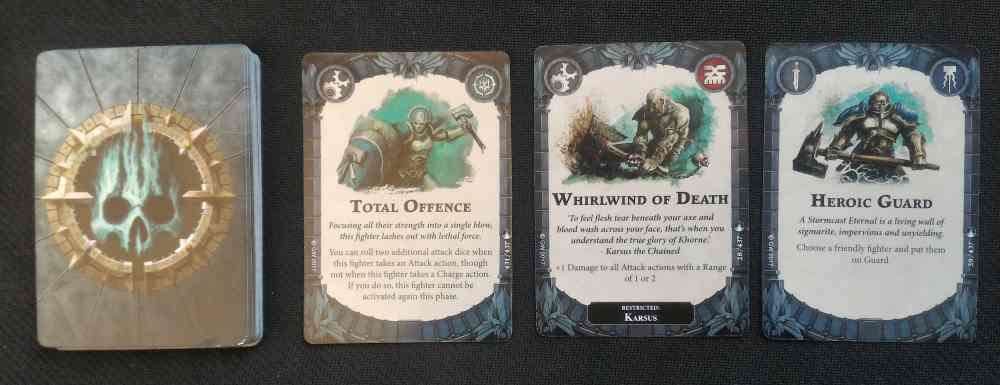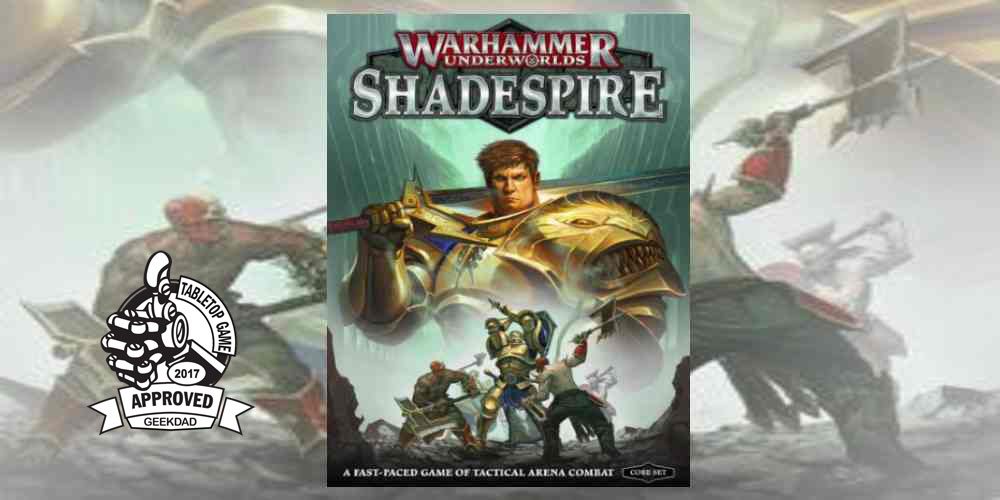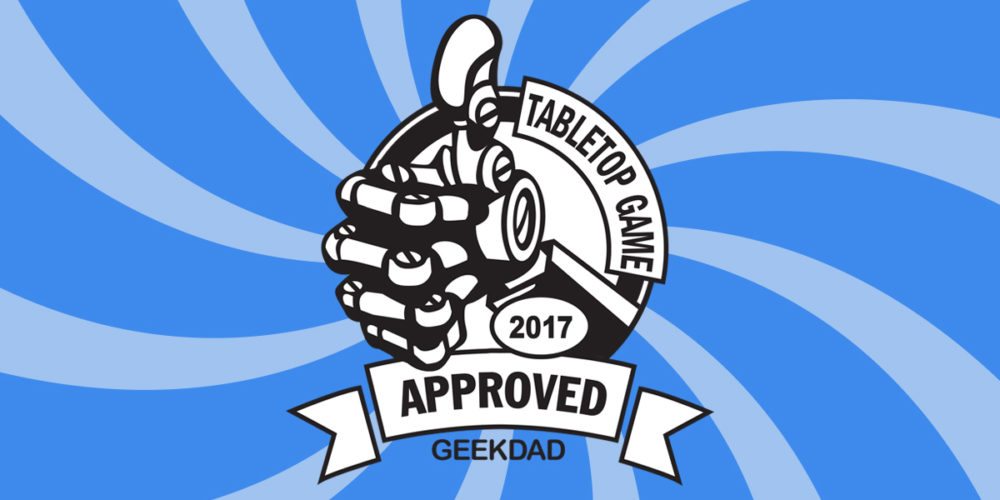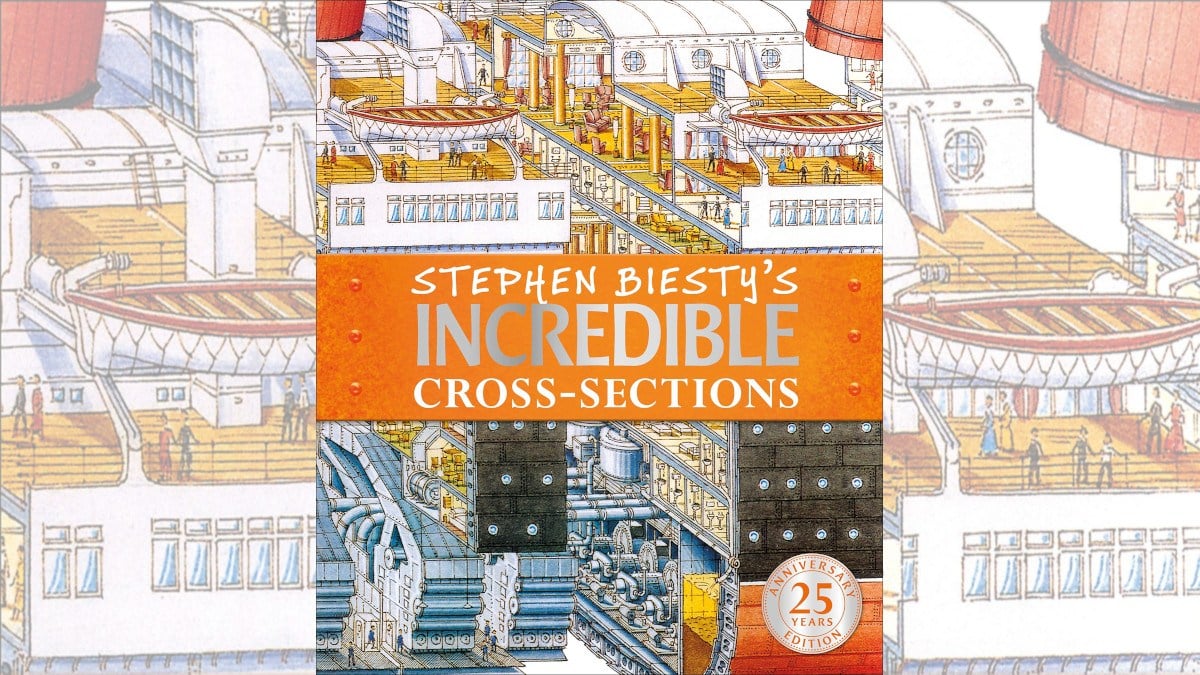
Strategic Miniatures Game, X-Wing competitor, or Collectible Card Game? There have been lots of questions surrounding Games Workshop’s latest release, Warhammer Underworlds: Shadespire. We took a look at the components of the game a few weeks ago and, with my Agents of Sigmar hat on, I’ve played some games and made a few videos of the experience.
In this review, I hope to get to the heart of the game, and explain exactly what sort of game it is, but also the kind of game it isn’t. Overall, I’ve been impressed by its ease of accessibility. That’s why I consider Shadespire to be GeekDad Approved.
Game Overview:
Trapped inside the twisted city of Shadespire, your warbands fight for many reasons. Some for good, some for blood and some for the glory.
The starter Shadespire set allows two players to pit two warbands against one another. Games take place over 3 rounds, each of four turns per player. The base set comprises two warbands with two more to be released on November 4. Each warband consists of a specific set of Citadel Miniatures. Extra players can be added to make 3- or 4-player games, but currently, this would require another base set, since the game requires a board section per player.
The core game mechanic uses custom dice and cards, 2 decks per player; one of objective cards, the other, power cards. Players can build their own custom decks from any available cards they have, though some cards can only be used by specific warbands.
Games last around 30 mins and take place on boards marked with hexagons. Tournament play is possible, with warbands fighting over the best of three games, with unchanging card decks.
Shadespire is the easiest entry-level game Games Workshop produces (with the possible exception of the asymmetric board game, Lost Patrol). Its core rules are simple to learn and game set up time is negligible. Play-time is quick too. How many other GW games can be completed in just half an hour? Not only that, the small model count makes the game an excellent jumping-off point into the wider world of hobby painting.
What’s in the Box?
For a detailed breakdown of what you can find in the Shadespire box, do check out our preview post and the video above.
Inside the box, you’ll find everything you need to play the game. Board sections, custom dice, counters, cards, and 8 Citadel Miniatures – 5 for the Khorne warband and 3 for Stormcast.
The cards are packaged 1 deck for the Khorne Warband and one for the Stormcast. They can be played straight out of the shrinkwrap. Once you’re familiar with the base cards, there is another deck of more advanced cards that can be incorporated into your games.
The miniatures included are “Easy to Build,” which means, in theory, they don’t require glue. I didn’t find that all of the models went together very well and did use some glue for a couple of them. You’ll probably need some polystyrene cement and definitely a craft knife or, better still, a pair of sprue clippers.
How Do I Play Shadespire?
Players choose which warband they want to use, or bring their warband along to the game with them. The initial release wave will bring 4 warbands in total. The two from the box and two more, Orcs (Ironskullz Boys) and Undead (The Sepulchral Guard.) You can play any warband against another (including two the same,) and, as stated above, there is no mixing and matching the persona of your warbands. This is something of a departure for Games Workshop and bears repeating.
Warband variation will come from the deckbuilding aspects of the game. Each warband pack will come with new cards to supplement those in the base set. Some cards are warband specific but others can be used more generally.
Battles are played over three rounds. By killing your opponent’s heroes and claiming the objectives in your objectives deck you will gain glory. The scorer of the most glory wins the game.
What follows is a general overview of the game. For a more detailed description of the game mechanics and tactics, see tomorrow’s follow-up post.

How do I create a deck?
Straight out of the box, this is easy as it comes with ready-made decks. Here though, are few general rules for Shadespire deckbuilding.
- The game requires two decks per player: Objective Deck (gold cards) and Powers Deck (grey cards).
- You must have 12 cards in your Objective Deck.
- You must have at least 20 Cards in your Powers Deck.
- You may only have 1 of each card in your decks.
How do I set up a game?
Lay your warband hero cards out in front of you, with their associated models. Hero cards have two sides. A silver basic side and a golden “inspired” side. Heroes start with the silver side face up.
There is a specific order in which the game is set up, with players rolling off to see who chooses who goes first for each step. Once the game is set up, players will have:
- Two boards sections placed together to form the playing arena
- Two warbands on starting hexes
- 5 objectives placed on the board
- Each player will have drawn three objective cards and five power cards
How do I play the game?
In order to win a game of Shadespire, you need to score as much glory from your 12 objectives cards as possible. This will be the focus of your gameplan. Most objective decks will contain a card each of the five objective tokens placed when setting up. Much of the action will center around these. Note: You can also score glory from killing your opponent’s heroes.
Glory is key to the game; not only are they victory points but they also act as currency to buy upgrades for your heroes. Glory tokens are gold on one side and grey on the other. When you win them they go gold side up, and when you spend them on an upgrade you turn them to the grey side. Note: All glory, spent or unspent on upgrades, counts towards the victory point total.
A Shadespire game has very little in common with its parent game Warhammer: Age of Sigmar. None of the traditional stats or stat blocks exist. Games are played over three rounds with two phases per round. The bulk of the action takes place, unsurprisingly, in the “Action Phase.”
An action phase is made up of “activations.” Four per player. Players take it in turn to activate. There are a number of actions a player can take. Generally, these will be Moving, Attacking, or Moving and then Attacking (Charging).
An activation (usually) only activates one hero at a time, which is unusual for a GW game, and players (usually) only get one action per activation, so choose wisely. Your opponent will be able to respond immediately, in their subsequent activation. Once a hero has moved it cannot move again, and if it has charged it can only fight once too. Choosing the right time to charge is vital to success.

After an Activation: The Power Step.
Between activations, players can play their power cards, taking it in turns, starting with the player whose activation it was. You can play any of the cards you hold in your hand. Ploy cards (marked with swords) can be played for free. They represent real-time tactical maneuvers. Upgrade cards (marked with cogs) require unspent glory to be used, costing one glory per card. Players can keep playing power cards until both players pass.
How does combat work?
The minutiae of combat are myriad (though not difficult to follow). Take a look tomorrow’s in-depth post for more details.
In broad terms, much like in X-Wing, the attacker rolls attack dice (given by a number on the relevant hero card) and the defender rolls defense dice. If the attacker has more successes than the defender, his attack is successful. Damage is an all-or-nothing thing. Success, no matter how slender, means all the damage is dealt. Failure means none of it gets through.
The game also has mechanisms for critical hits and multiple models providing support.
One of the key elements of the game is the concept of heroes becoming “inspired.” Each hero can become inspired and when they do, they become a better version of themselves.
What is the End Phase?
Once all players have made four activations and the final power step completed, play moves to the end phase. In the end phase, players score any objectives they have achieved and can discard unwanted cards, and replenish their hands. If they have unspent glory they can also upgrade their heroes.
Once both players have completed their end phase, assuming it’s not the final round, players roll off to see who chooses who goes first in the next round. If it is the final round (round 3), there is no need to redraw cards. Objective points are totaled and the winner declared.
What happens beyond the mechanics?
The game when you start to play can feel quite mechanical, but the mechanics are straightforward. Play a few hands, and you’ll discover you need to be tactically astute. The game is not the slugfest it might have been. With only four activations per round, you have to think about the best way to bring your heroes into the action. If you charge straight in, then immediately that hero is out of action for the rest of the round. The game’s mechanics may be rigid, but it’s your job as players to find whatever flexibility you can, through miniature placement, card choice, and how you use your activations.
What about your objectives? Beating your opponent up won’t necessarily get you any. 5 of the 12 cards in the initial objective decks are for the 5 numbered and randomly placed objective markers. The other seven involve varying feats of prowess or territory claiming, and you’ll need to work out which ones are best captured by your warband. In-game, you have to continually think about the best way to maximize your opportunity to score glory. That might be to bring down your opponent’s heroes but may equally be by dashing into open territory to claim a lone objective.
You have 12 turns in this game, and you have to make each one count. Every decision is important, from board placement, objective setup, and hero starting position. From the moment the game starts, you need to be thinking about your objectives.
The Power Step is vital. How you stack your deck, and what you do with the cards that come out, makes the difference between winning and losing. Some of this will come down to how you’ve built your deck. For those moving beyond the basic game, it means the path to victory begins long before arriving on the tabletop.
How does the game evolve?
In a traditional Games Workshop game, a player’s gaming experience changes as they acquire new models, usually to rain a more severe form of death down upon their opponents.
Shadespire isn’t like that. You can only alter your warband’s effectiveness by adding or taking cards from them. There are two decks to build and how you do so will inform how you play your game.

Killing all of your opponent’s heroes seems like the most obvious way to win, but doing so is tricky. Planning a warband tactic before the game, through your deck-building, and working to that plan once your warband is on the table is what is going to bring the most victories.
Do I need lots of money to remain competitive?
I don’t play games competitively, so possibly there’s some angle I’m missing here, but it seems to me that Shadespire is kind to those who don’t want to enter into a world of “pay to win.”
The main reasons for this are the small card numbers in the decks and because they can have only 1 card of each type. There will be no buying of blind blisters trying to track 4 copies of the same killer card. Nor will you have an X-Wing situation where you want to buy multiple copies of the same ship, one you don’t even need, to get a card that gives a tactical edge.
New Warbands will have generic cards in them that can be used by all players, but at the most, you’ll only need 1 set. Just over half (31 v 29) cards in the booster sets are non-specific, which will make them tempting. It seems inevitable that the new packs will have desirable cards in them. One or two probably won’t make an enormous amount of difference to deck competitiveness. There are no absolutely “must have” cards in the base set, and I hope this would be the case with any follow-ups.
There are, however, 62 new factionless cards to play from the two new sets, and keen players are going to want some of this action. It is my hope that the new packs will offer alternative play styles, rather than “can’t win without” cards. It will be a shame if the Shadespire model is that anybody who wants to remain competitive has to keep spending money. It’s my hope that it won’t but perhaps I’m being naive.
The additional cost for a new warband is moderate ($30 a pack), with only two available now and two more promised in the New Year, so you can spread the cost a little too. The quality of the figures is such that, if you only want the cards, you’ll be able to sell the figures on to Warhammer players fairly easily.
Warhammer: Shadespire is GeekDad Approved!
Should I Buy Warhammer: Shadespire?
The answer to this does depend a little on what you’re looking for in a game. Shadespire is not a board game. It’s still a tactical skirmish wargame. If you don’t like those, don’t buy it.
From a geek parent perspective, I think it’s a brilliant game. It doesn’t have the “Wow! It’s Star Wars!” appeal of X-Wing, but I think it’s a better game, particularly for children. It’s definitely better for younger players than full games of Warhammer.
Shadespire’s strong selling point for busy households, filled with family clutter, is its ease of setup and quick playing time. It plays easily on a 3′×3′ space and you can have a single game in 30 minutes, once you know what you’re doing.
When playing X-Wing with the children, I find the importance of ships maintaining their orientation challenging, especially when playing with my never-sit-still 8-year-old. Each time a ship is knocked over, there’s the question of what angle it was facing. With Shadespire the models are a) more stable and b) can face any way you like.
The combat rules are simple in essence and very visual for children who don’t want to hold numbers in their heads.
This is definitely a gateway game. It’s likely to lead to more purchases of plastic. If you’ve read this far, you probably aren’t against that idea. Shadespire has more depth than a straight collectible card game. You won’t find little discarded stacks of cards all over the house, because the latest booster didn’t have cards that improved on what your children already had.
Shadespire opens up the modeling side of the hobby, in an easy to manage manner. If you pick up one of Games Workshop’s larger boxed base sets, you get hoards of miniatures, which in my experience are overwhelming for young gamers. They can’t see the end of painting tunnel. With Shadespire, you get 8 excellent miniatures, which, with a small amount of application, most families can get painted. The “easy to build” tag didn’t quite live up to its billing. Assembling the minis wasn’t as easy as some of the other miniatures in the same range. Nevertheless, Shadespire is a great intro into the creative side of the hobby.
All in all, I’ve been very impressed with Shadespire. It’s a new venture for Games Workshop and one that suggests it is thinking about offering something to appeal to gamers beyond their traditional fanbase. I hope they continue to support Shadespire as strongly as this initial release, as it’s a game that could run and run. It’s a great way to dip into the Warhammer universe for those who would love to visit more often, but find the real world keeps us from the Realmgates.
Click here to see all our tabletop game reviews.
If you’d like to stay up-to-date with all of our tabletop gaming coverage, please copy this link and add it to your RSS reader.
Disclosure: GeekDad received a copy of this game for review purposes.






Great write up, this is actually the first GW game my 12 year old son liked. I would like to point out though that killing the other team is not an auto win. The rules state that play continues and both players can continue to score until the end of phase 3.
Yep, you’re right Jason. I thought I’d mentioned that. I’ve sort of implied it but not explicitly stated, I think.
It’s one of the more interesting aspects of the game, there being more than one way to win. Having said that, I’ve yet to play a game where a warband that was completely wiped out, won the game.
Glad you enjoyed the write up, look out for some more Shadespire content soonish…